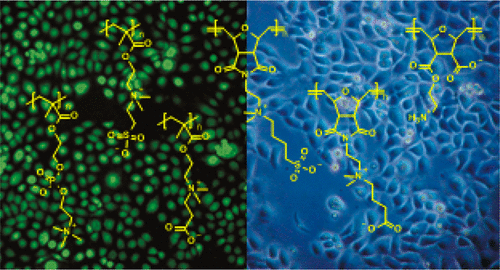当前位置:
X-MOL 学术
›
ACS Appl. Polym. Mater.
›
论文详情
Our official English website, www.x-mol.net, welcomes your
feedback! (Note: you will need to create a separate account there.)
Polyzwitterions: From Surface Properties and Bioactivity Profiles to Biomedical Applications
ACS Applied Polymer Materials ( IF 4.4 ) Pub Date : 2020-01-30 , DOI: 10.1021/acsapm.9b00897 Stefan Paschke 1 , Karen Lienkamp 1
ACS Applied Polymer Materials ( IF 4.4 ) Pub Date : 2020-01-30 , DOI: 10.1021/acsapm.9b00897 Stefan Paschke 1 , Karen Lienkamp 1
Affiliation

|
Long-term biocompatible materials (i.e., nontoxic materials that sustain the healthy functions of surrounding tissue, cause no inflammatory response, and are tissue-integrated without encapsulation) remain elusive. Added to this, poly(ethylene glycol), the “gold standard” for polymeric biomaterials, has been recently reported to be immunogenic. In this setting, protein-repellent, nonthrombogenic, and cell-compatible polyzwitterions are attracting increased scientific interest, particularly in the context of biomedical applications. Due to their high density of charged groups with opposite sign, polyzwitterions are strongly hydrated under physiological conditions yet do not disturb the hydrogen bonding of adjacent bulk water. For this reason, in combination with other enthalpic and entropic contributions, adhesion of biological matter to polyzwitterions is strongly reduced. Their protein repellency and cell compatibility designates them as promising coatings for medical devices such as catheters, wound dressings, and implants. Nowadays, a rich variety of polyzwitterionic structures is accessible, but their potential for various applications still needs to be evaluated. In this context, this work reviews the field of polyzwitterionic surfaces used for biomedical applications. In particular, the interaction of polyzwitterions with biological media and with living organisms such as mammalian cells and bacteria are highlighted. So far, the beneficial properties of polyzwitterions have been deemed to result from their inertness. Yet, very recent research shows that formally polyzwitterionic molecules can be in fact bioactive due to stimulus responsiveness.
中文翻译:

聚两性离子:从表面性质和生物活性概况到生物医学应用
长期的生物相容性材料(即维持周围组织健康功能,不引起炎症反应,并且无需封装即可与组织整合的无毒材料)仍然难以捉摸。除此之外,最近有报道称聚乙二醇是聚合生物材料的“金标准”,具有免疫原性。在这种情况下,特别是在生物医学应用的背景下,蛋白质排斥,非血栓形成性和细胞相容性的两性离子吸引了越来越多的科学兴趣。由于两性离子具有相反符号的带电基团的高密度,因此它们在生理条件下会被强烈水合,但不会干扰相邻大量水的氢键。因此,结合其他焓和熵贡献,生物物质对两性离子的粘附力大大降低。它们的蛋白排斥性和细胞相容性使它们成为用于医疗器械(如导管,伤口敷料和植入物)的有前途的涂层。如今,可以获取多种多样的聚两性离子结构,但仍需要评估其在各种应用中的潜力。在这种情况下,这项工作回顾了用于生物医学应用的两性离子表面领域。特别地,突出了多两性离子与生物介质以及与诸如哺乳动物细胞和细菌的活生物体的相互作用。迄今为止,已经认为聚两性离子的有益性质是由于它们的惰性。然而,
更新日期:2020-01-31
中文翻译:

聚两性离子:从表面性质和生物活性概况到生物医学应用
长期的生物相容性材料(即维持周围组织健康功能,不引起炎症反应,并且无需封装即可与组织整合的无毒材料)仍然难以捉摸。除此之外,最近有报道称聚乙二醇是聚合生物材料的“金标准”,具有免疫原性。在这种情况下,特别是在生物医学应用的背景下,蛋白质排斥,非血栓形成性和细胞相容性的两性离子吸引了越来越多的科学兴趣。由于两性离子具有相反符号的带电基团的高密度,因此它们在生理条件下会被强烈水合,但不会干扰相邻大量水的氢键。因此,结合其他焓和熵贡献,生物物质对两性离子的粘附力大大降低。它们的蛋白排斥性和细胞相容性使它们成为用于医疗器械(如导管,伤口敷料和植入物)的有前途的涂层。如今,可以获取多种多样的聚两性离子结构,但仍需要评估其在各种应用中的潜力。在这种情况下,这项工作回顾了用于生物医学应用的两性离子表面领域。特别地,突出了多两性离子与生物介质以及与诸如哺乳动物细胞和细菌的活生物体的相互作用。迄今为止,已经认为聚两性离子的有益性质是由于它们的惰性。然而,











































 京公网安备 11010802027423号
京公网安备 11010802027423号